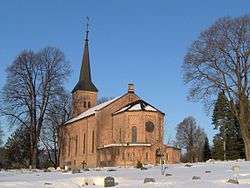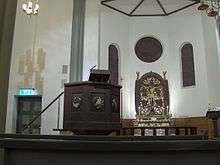Bryn Church
| Bryn Church | |
|---|---|
 | |
 Bryn Church Location in Akershus | |
| 59°55′15.632″N 10°29′17.981″E / 59.92100889°N 10.48832806°ECoordinates: 59°55′15.632″N 10°29′17.981″E / 59.92100889°N 10.48832806°E | |
| Location | Rykkinn, Akershus |
| Country | Norway |
| Denomination |
|
| Churchmanship | Evangelical Lutheran |
| Architecture | |
| Status | Parish church |
| Functional status | Active |
| Architect(s) | Peter Høier Holtermann |
| Completed | 1861 |
| Specifications | |
| Capacity | 400[1] |
| Materials | Brick |
| Administration | |
| Parish | Bryn |
| Deanery | Bærum |
| Diocese | Diocese of Oslo |
Bryn Church (Norwegian: Bryn kirke) is a long church (Norwegian: langkirke) located in Rykkinn in the municipality of Bærum in Akershus county, Norway. It was built in 1861 based on plans by the architect Peter Høier Holtermann.[2]:21 The church is made of brick and can accommodate 400 people.[1] There is a cemetery next to the church.[1][3] The church functions as a road church and is the parish church for Bryn.
An urn with the remains of the film director Rasmus Breistein is kept at the church.[4]
History

The church was built in 1861 and was inaugurated in a major ceremony on June 28, 1861. Gunder Kristensen Krydsby from Lommedalen transported the two church bells from Oslo by horse and wagon.
The newspaper Ringeriges Ugeblad (now Ringerikes Blad) wrote that: "Already early in the morning, crowds were seen along all the roads heading to the church. About 800 admission tickets were given out. The church opened at 9:30, and those that had tickets were able to enter and take their place. At 10:00 the procession set out from the Bryn farm. It consisted of ten priests from the deanery. The town's new and very attractive church was consecrated."[2]:49
Some of the church's furnishings were newly purchased, some were received as gifts, and some were transferred from the much older Tanum Church. The chancel decoration was created by Emanuel Vigeland, the brother of the better known Gustav Vigeland.[2]:55
The church was restored in 1959–60 by the architect Finn Bryn.[2]:68 In 2007–2008 the church spire was repaired, and an old scroll was found in the soffit relating how the church's foundation stone was laid, who had participated in the construction of the church, and who had paid for the work.
The cemetery, measuring 70 mål (7 hectares or 17 acres), is planned to be expanded by 60 mål (6 hectares or 15 acres) and excavation work has started. The digging has revealed a number of archaeological finds from the early Iron Age from c. 500 BC and from the Middle Ages, including graves and traces of settlement from the Iron Age.
Sesquicentennial
The celebration of the church's sesquicentennial in 2011 involved concerts, exhibits, and a special anniversary religious service in the church. A volume commemorating the anniversary was edited by Bjørn Sandvik.[5]
References
- 1 2 3 "Kirkesøk". kirkesøk.no. Retrieved January 26, 2016.
- 1 2 3 4 Bakken, T. J. 1961. Bryn kirke, 1861–1961. Oslo: V. Bærums menighetsraad.
- ↑ Kjernlie, Eira. 2015. Slipper gravstell med fellesordning. Budstikka (August 24).
- ↑ Norsk biografisk leksikon: Rasmus Breistein.
- ↑ Jakobsen, Olav. 2011. Bryn kirke 150 år. Et gammelt hus i stadig endring. Bryn kirketidende 34(2): 8–9.